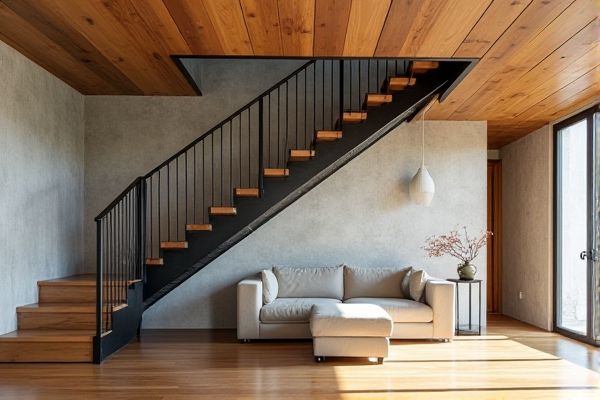
Wood stairs offer a warm, classic aesthetic and can be customized with various finishes, while metal stairs provide greater durability and a modern, industrial look perfect for high-traffic areas. Explore the rest of the article to determine which material best suits Your style and functional needs.
Table of Comparison
| Feature | Wood Stairs | Metal Stairs |
|---|---|---|
| Material | Hardwood (oak, maple, cherry) | Steel, aluminum, wrought iron |
| Durability | Moderate; susceptible to wear, moisture | High; resistant to rust and damage |
| Maintenance | Regular polishing and sealing required | Low; occasional painting or rust prevention |
| Design Flexibility | Traditional and warm aesthetics | Modern, sleek, and industrial designs |
| Cost | Moderate to high depending on wood type | Varies; generally higher initial cost |
| Weight | Lighter; easier to install | Heavier; requires strong structural support |
| Fire Resistance | Low; susceptible to fire damage | High; fire-resistant |
| Environmental Impact | Renewable if sourced responsibly | Non-renewable, recyclable metals |
Overview of Wood vs Metal Stairs
Wood stairs offer a classic, warm aesthetic with customizable grain patterns and natural textures, making them ideal for residential settings seeking a traditional or rustic feel. Metal stairs provide superior durability, strength, and modern design flexibility, often used in commercial or industrial spaces due to their resistance to wear and environmental factors. Your choice between wood and metal stairs will depend on factors like budget, maintenance preferences, and the desired architectural style.
Aesthetic Appeal and Design Flexibility
Wood stairs offer natural warmth, rich textures, and timeless elegance, making them ideal for traditional and rustic interiors, while their ability to be carved or stained provides extensive design customization. Metal stairs excel in modern and industrial aesthetics with sleek lines and minimalist forms, allowing for innovative shapes and open riser designs that enhance light flow and spatial perception. Both materials support diverse architectural styles, but wood emphasizes organic beauty and tactile comfort, whereas metal prioritizes contemporary, durable, and sculptural possibilities.
Durability and Longevity Comparison
Wood stairs offer natural beauty and moderate durability but are susceptible to moisture, insects, and wear over time, requiring regular maintenance to prolong their lifespan. Metal stairs, constructed from steel or aluminum, provide superior durability and resistance to environmental damage, making them ideal for both indoor and outdoor use with minimal upkeep. The longevity of metal stairs often exceeds that of wood, lasting several decades even under harsh conditions, whereas wood stairs may need restoration or replacement within 10 to 20 years depending on usage and maintenance.
Cost Analysis: Installation and Maintenance
Wood stairs generally offer a lower initial installation cost compared to metal stairs due to cheaper materials and simpler construction methods. However, wood requires regular maintenance such as sealing, sanding, and potential repairs to prevent rot and wear, increasing long-term expenses. Metal stairs have a higher upfront cost but benefit from lower maintenance needs, as they resist corrosion and damage, making them cost-effective over time for durable, long-lasting use.
Safety Features and Performance
Wood stairs offer natural slip resistance and can be enhanced with non-slip treads, providing a warm, secure footing ideal for residential settings. Metal stairs boast superior strength, durability, and fire resistance, often incorporating perforated surfaces or anti-slip coatings to enhance safety in industrial or commercial environments. Both materials require proper maintenance to prevent hazards such as wood rot or metal corrosion, ensuring long-term performance and user safety.
Environmental Impact and Sustainability
Wood stairs typically have a lower environmental impact due to the renewable nature of timber and its ability to sequester carbon during growth, especially when sourced from sustainably managed forests certified by organizations like FSC or PEFC. Metal stairs, often made from steel or aluminum, require significant energy-intensive mining and manufacturing processes that contribute to higher carbon emissions, though their recyclability can mitigate some environmental concerns when end-of-life recycling is practiced. Choosing wood stairs with certified sustainable sourcing and durable finishes enhances sustainability by reducing resource depletion and promoting long-term ecological balance.
Ease of Installation and Customization
Wood stairs offer greater ease of customization due to their workability, allowing for intricate designs and adjustments during installation without specialized tools. Metal stairs, while typically requiring professional installation due to welding and precise measurements, provide consistent durability and can be prefabricated for faster on-site assembly. Both materials support various customization options, but wood stairs excel in flexible modifications and aesthetic detailing during installation.
Noise and Comfort Levels
Wood stairs offer superior noise reduction and comfort compared to metal stairs, as their natural material absorbs sound and provides a warmer, quieter walking experience. Metal stairs tend to amplify footsteps and produce louder clanging noises, which can be disruptive in residential and office environments. The softness and slight flexibility of wood make it more comfortable underfoot, while metal's rigidity often results in a harsher, less forgiving surface.
Common Applications and Suitability
Wood stairs are commonly used in residential settings and traditional interiors due to their warm aesthetic and ease of customization, making them suitable for low to moderate traffic areas. Metal stairs are ideal for commercial and industrial environments because of their durability, fire resistance, and ability to withstand heavy foot traffic and harsh conditions. Both materials offer versatility, but wood suits spaces prioritizing design and comfort, while metal excels in structural strength and longevity.
Choosing the Right Material for Your Stairs
Wood stairs offer warmth, natural aesthetics, and versatility in design, making them ideal for traditional or rustic interiors, while metal stairs provide exceptional durability, modern appeal, and resistance to environmental factors, suited for industrial or contemporary spaces. Consider factors such as budget, maintenance requirements, safety features, and architectural style when choosing between wood and metal stairs. The decision impacts longevity, comfort, and overall ambiance, with wood favored for its organic texture and metal preferred for structural strength and sleek design.
 homyna.com
homyna.com